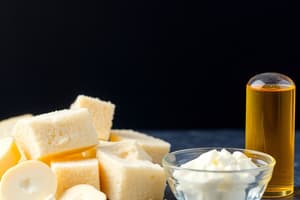Podcast
Questions and Answers
What is the primary function of lipase in the digestive system?
What is the primary function of lipase in the digestive system?
- Convert proteins into amino acids
- Provide energy directly to cells
- Break down starch into glucose
- Digest fats into fatty acids and glycerol (correct)
Which food test reagent produces a blue-black color when a positive result is detected?
Which food test reagent produces a blue-black color when a positive result is detected?
- Litmus solution
- Benedict's solution
- Iodine solution (correct)
- Biuret solution
What is the breakdown product of starch during digestion?
What is the breakdown product of starch during digestion?
- Glucose (correct)
- Fatty acids
- Glycerol
- Amino acids
During digestion in the stomach, which substance helps to create an optimum pH for protease enzymes?
During digestion in the stomach, which substance helps to create an optimum pH for protease enzymes?
What does the formula for calculating energy released from food per gram take into account?
What does the formula for calculating energy released from food per gram take into account?
Which digestive enzyme is secreted by the pancreas into the small intestine?
Which digestive enzyme is secreted by the pancreas into the small intestine?
Which of the following correctly describes the role of proteases in digestion?
Which of the following correctly describes the role of proteases in digestion?
What color change indicates a positive result when using Benedict's solution to test for glucose?
What color change indicates a positive result when using Benedict's solution to test for glucose?
Flashcards
Proteases
Proteases
Enzymes that break down proteins into amino acids, important for growth and tissue repair.
Lipases
Lipases
Enzymes that break down fats (lipids) into fatty acids and glycerol for energy and insulation.
Amylase
Amylase
Enzymes that break down starch (a carbohydrate) into glucose for energy.
Iodine Test
Iodine Test
Signup and view all the flashcards
Benedict’s Test
Benedict’s Test
Signup and view all the flashcards
Digestion
Digestion
Signup and view all the flashcards
Oesophagus
Oesophagus
Signup and view all the flashcards
Stomach
Stomach
Signup and view all the flashcards
Study Notes
Digestive Enzymes
- Proteins are broken down into amino acids by proteases. This aids in growth and repair of tissues.
- Fats (lipids) are broken down into fatty acids and glycerol by lipases. This provides energy and insulation.
- Starch (carbohydrates) are broken down into glucose by amylase (carbohydrase). This provides energy.
Food Tests
- Protein is tested using Biuret reagent. A positive result is a lilac color.
- Starch is tested using iodine solution. A positive result is a blue-black color.
- Glucose is tested using Benedict's solution. A positive result is a change in color from green to blue to orange ppt (precipitate).
Digestion Process
- Food is chewed and mixed with saliva containing amylase in the mouth.
- The food travels down the oesophagus to the stomach.
- The stomach secretes protease to break down proteins into amino acids and hydrochloric acid to kill bacteria.
- The food then moves to the small intestine.
- Pancreatic secretions (lipases, proteases, carbohydrases) enter the small intestine.
- Carbohydrates are broken down into glucose.
- Proteins are broken down into amino acids.
- Fats are broken down into fatty acids and glycerol.
- Any undigested material passes into the large intestine where water is absorbed, forming faeces that are eliminated.
Calculating Energy Content of Food
- Calculate the energy released by measuring the initial and final temperature of water surrounding a burning food sample using this formula: Energy (J) = mass of water (g) * temperature rise (°C) * 4.2/mass of food sample (g)
Studying That Suits You
Use AI to generate personalized quizzes and flashcards to suit your learning preferences.
Related Documents
Description
Explore the fascinating world of digestive enzymes and food testing with this quiz. Learn how proteins, fats, and carbohydrates are broken down in the body, and test your knowledge on identifying nutrients using various reagents. Perfect for reinforcing your understanding of digestion and nutrition!




